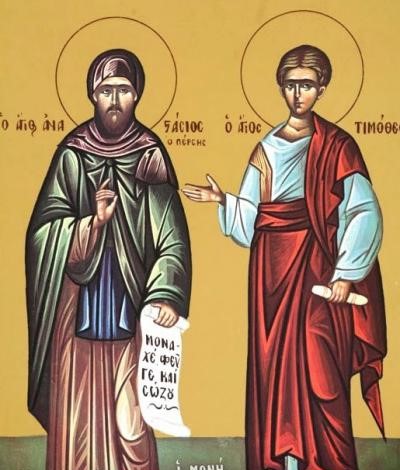
Saint of the Day for 26 January: Saints Timothy and Titus
Saints Timothy and Titus: Disciples of Paul and Pillars of the Early Church
Name
Saints Timothy and Titus
Title
Bishops Disciples of St. Paul
Recurrence
26 January
Martyrology
2004 edition
Roman Martyrology
Memory of Saints Timothy and Titus, bishops, who, disciples of St. Paul the Apostle and his co-workers in the ministry, were the one head of the Church of Ephesus, the other of the Church of Crete; to them are addressed the Epistles from the wise recommendations for the instruction of pastors and the faithful.
The Saint and Mission
Saints Timothy and Titus, crucial figures in the history of early Christianity, embodied a mission of faithfulness, guidance and consolidation of the nascent Church. As close co-workers and disciples of St. Paul the Apostle, they played a significant role in transmitting and entrenching Christian teachings in the communities to which they were sent. Their mission, strongly influenced by Paul’s work and teaching, was characterized by a deep commitment to the faith and a strong sense of pastoral responsibility. Timothy and Titus not only spread the message of the Gospel but also devoted themselves to the formation of Christian communities, establishing structures, settling disputes, and promoting sound and orthodox religious practice. What distinguished their mission was the combination of doctrinal fidelity and pastoral sensitivity. They were keenly aware of the challenges and needs of the communities they served, adapting their approach to respond effectively to different situations. Through their letters and actions, they showed a balance between maintaining the integrity of apostolic teachings and understanding local cultural and social realities. In Timothy and Titus we see the importance of spiritual leadership that is both rooted in tradition and attentive to the needs of the present. Their lives and ministry are an example of how fidelity to doctrine and pastoral care can coexist and reinforce each other, a model that continues to be relevant to church leadership today. Their mission teaches us that true spiritual leadership requires not only knowledge and conviction, but also empathy, flexibility and an unwavering commitment to the well-being of the community.
The Saint and Mercy
Saints Timothy and Titus, as key figures in the spread of early Christianity, deeply embody the value of mercy in their mission and ministry. Their closeness to St. Paul the Apostle and their involvement in founding and leading early Christian communities reflect an approach that is deeply rooted in mercy and understanding. These two saints demonstrated mercy not only in the traditional sense of compassion and care for those in need, but also in their ability to listen, welcome and guide the diverse communities to which they were sent. Their ability to adapt to different cultural contexts and situations while maintaining fidelity to the principles of the Gospel shows a deep understanding of humanity and its various facets. Timothy and Titus, through their service, exemplified mercy as a fundamental principle of Christianity-not just as an act of beneficence, but as a fundamental attitude that guides all action. Their ability to forgive, mediate in conflicts and offer spiritual guidance with kindness and patience are aspects that underscore their deep mercy. In them, we see how mercy is essential for effective spiritual leadership. They teach us that being merciful means understanding the challenges and struggles of others and responding with an open heart and practical help. Their legacy reminds us that, at the heart of Christian service, there must always be a deep sense of mercy, which is manifested not only in words, but especially in daily actions of love and service to others.
Hagiography
The memory of two bishops of the very first Christian generations, both converts of St. Paul and his associates, has been matched in the new Church Calendar. Timothy and Titus were not Israelites; they did not belong to the Chosen People. Both therefore personified the first major problem encountered by the nascent Church. The problem was this: was it permissible to enter the Christian Church without first passing through the Jewish Synagogue? Could pagans be baptized directly, or was baptism to be reserved only for the circumcised? The question was addressed by the Apostles, in Jerusalem, around the year 50, at what can be called the first Council of the Church. The dispute was lively, but St. Paul, though an Israelite, supported the arguments of the converted Gentiles, and…
